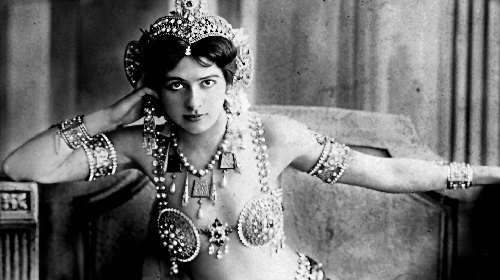Mata Hari is one of the most enigmatic and captivating figures in the history of global espionage. Her life, full of intrigue, secrets and mystery, has been the source of inspiration for books, films and plays. Below, we will explore her story, the impact of her actions and the legacy she left on the world of espionage .

Table of Contents
- Mata Hari's story
- Mata Hari's role as a spy
- The trial and the controversy
- Impact and legacy in popular culture
- Conclusions
Mata Hari 's story
Margaretha Geertruida Zelle, known as Mata Hari, was born in the Netherlands in 1876. From a young age she showed an adventurous character that led her to adopt the identity of " Mata Hari ", a name that means "eye of the day" in Malay. After a failed marriage and a life in search of opportunities, Mata Hari moved to Paris, where she began to gain popularity as an exotic dancer and actress, taking advantage of her sensual and mysterious style to captivate Parisian society. Her performances, inspired by the Orient and Eastern mysticism, made her a popular figure, gaining notoriety as a symbol of the femme fatale.
Beyond her life as a dancer, however, Mata Hari is suspected of having led a double life as a spy during World War I. Her influence among high-ranking diplomats and officers put her at the centre of an espionage plot in which she was allegedly working for both Germany and France. This duality of loyalties makes her a fascinating and ambiguous character that continues to raise questions about her true identity and intentions.
Mata Hari's role as a spy
During the years of the First World War, Mata Hari was recruited as a spy , or at least that is the official version that is known. Her contact with influential figures of different nationalities and her access to confidential information from governments and high military commands made her a valuable piece in the espionage game. It is important to remember that, at that time, espionage had a high component of personal relationships, which made it easier for Mata Hari to use her seduction skills to obtain information.
There are many theories about Mata Hari's activities as a double agent. Some believe she was actually working for the Germans, while others maintain that she was used as a scapegoat by the French, who were looking to blame someone for their military failures. To this day, it remains a mystery whether Mata Hari was truly a spy committed to a cause or simply a woman caught up in a dangerous game she did not fully understand.
Relationship between Mata Hari and the intelligence of the time
Wartime espionage was in its early stages of formal development. The figure of Mata Hari represents the archetype of the exotic and seductive spy, who used her charisma and attractiveness to achieve her goals. However, Mata Hari 's role is more complex, as her involvement in intelligence circles seems to have been based on manipulation and her vulnerability to the governments around her. This ambiguity in her role as a spy adds a layer of complexity to her story and to the theories about her actions.
The trial and the controversy
In 1917, Mata Hari was arrested by the French government and charged with espionage. Her trial was highly controversial and is riddled with contradictions, as in many cases, the evidence presented was dubious or lacking in substance. Nevertheless, she was sentenced to death and executed in October of that same year. Controversy over her guilt or innocence has persisted over the years, with many scholars arguing that Mata Hari was convicted without any conclusive evidence and that her execution was more of an act of propaganda than true justice.
The case of Mata Hari is an example of how public figures can be manipulated and sacrificed in times of crisis, especially when governments need to find culprits to divert attention from their own mistakes. The story of her trial remains one of the great injustices of the 20th century, and her life has inspired numerous investigations and historical reviews that attempt to unravel the truth.
Impact and legacy in popular culture
Mata Hari has become a legend in popular culture. Her life and role as a supposed spy have inspired novels, films, and historical studies, consolidating her image as a symbol of mystery and seduction. Mata Hari represents the archetype of the modern spy, with a personality that combines intelligence, charisma, and the ability to manipulate situations to her advantage. Her story has been recreated in multiple formats, from film to literature, remaining relevant as an icon of femininity and hidden power.
Mata Hari’s legacy has also influenced how we perceive women in espionage. Today, the figure of the female spy remains a symbol of mystery and skill in the art of manipulation and stealth. However, it is important to recognise that behind the legend of Mata Hari there was a real person with a complex life, whose actions and decisions led her to a tragic and unjust fate.
Conclusions
Mata Hari remains an icon of espionage and a symbol of intrigue, seduction and mystery. Her nuanced and controversial story has given rise to multiple interpretations and continues to capture the imagination of people around the world. Although it will never be known for certain whether she was truly a spy or a victim of the politics of the time, her figure remains a warning about the dangers of power games and the vulnerability of public figures in times of conflict. Mata Hari represents the complexity of human nature and the enigma of espionage, a world in which loyalty and betrayal are always intertwined.






 WhatsApp
WhatsApp Telegram
Telegram


